Conflict Resolution: Methods for Sammy and Ben's Dispute Analysis
VerifiedAdded on 2020/05/03
|21
|5004
|46
Report
AI Summary
This report delves into the principles of conflict creation and explores various methods of dispute resolution, using academic literature to analyze a conflict scenario between Sammy and Ben. The report examines the creation of conflict through various lenses, including economic, emotional, and structural factors, highlighting how differing values, unmet needs, and communication breakdowns can lead to disputes. Furthermore, it provides an in-depth analysis of two key conflict resolution methods: negotiation and mediation. The report details the advantages and disadvantages of each approach, specifically considering their applicability to the Sammy and Ben case, emphasizing the potential for cost-effectiveness and mutually agreeable outcomes. By evaluating these methods, the report aims to provide a comprehensive understanding of effective conflict management strategies.
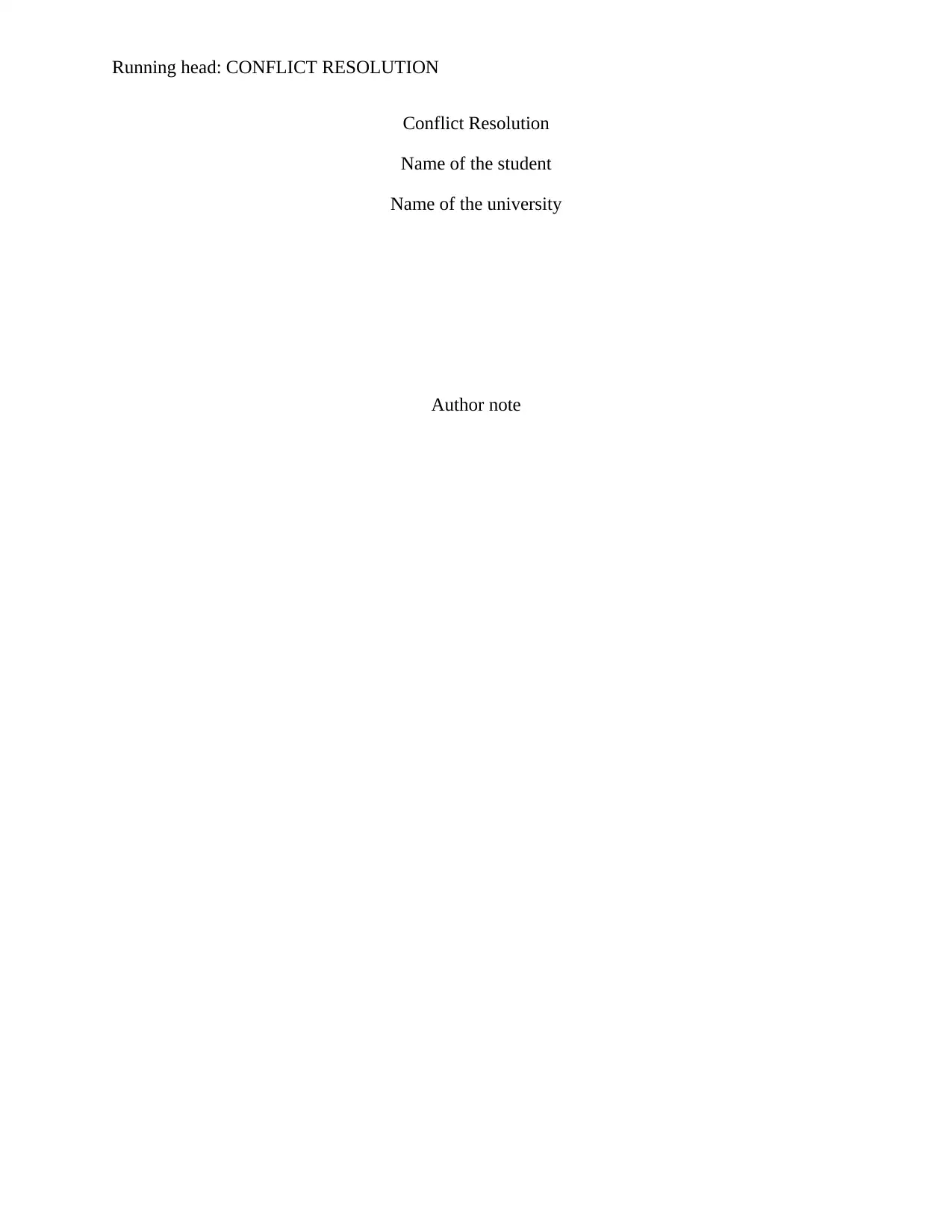
Running head: CONFLICT RESOLUTION
Conflict Resolution
Name of the student
Name of the university
Author note
Conflict Resolution
Name of the student
Name of the university
Author note
Paraphrase This Document
Need a fresh take? Get an instant paraphrase of this document with our AI Paraphraser
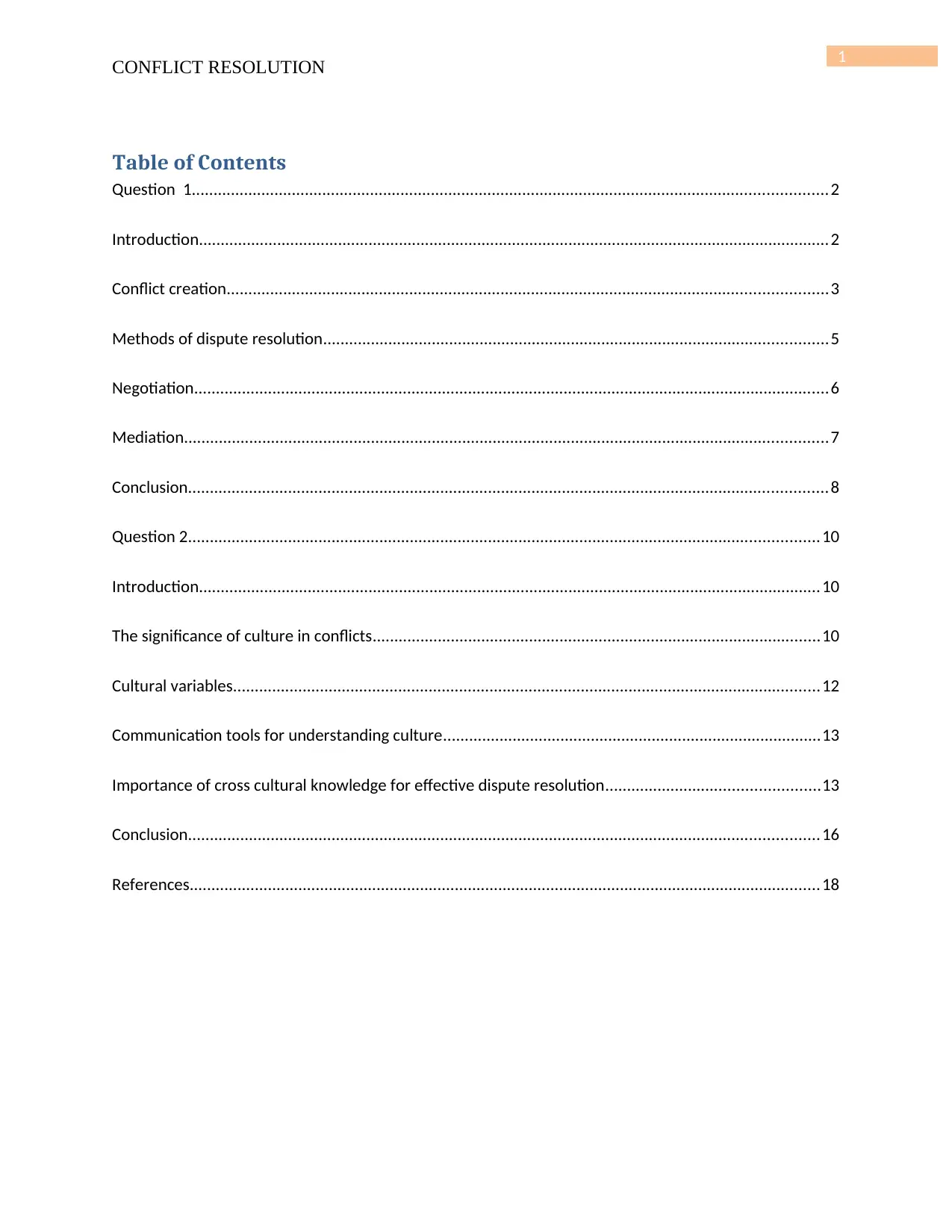
1
CONFLICT RESOLUTION
Table of Contents
Question 1..................................................................................................................................................2
Introduction.................................................................................................................................................2
Conflict creation..........................................................................................................................................3
Methods of dispute resolution....................................................................................................................5
Negotiation..................................................................................................................................................6
Mediation....................................................................................................................................................7
Conclusion...................................................................................................................................................8
Question 2.................................................................................................................................................10
Introduction...............................................................................................................................................10
The significance of culture in conflicts.......................................................................................................10
Cultural variables.......................................................................................................................................12
Communication tools for understanding culture.......................................................................................13
Importance of cross cultural knowledge for effective dispute resolution.................................................13
Conclusion.................................................................................................................................................16
References.................................................................................................................................................18
CONFLICT RESOLUTION
Table of Contents
Question 1..................................................................................................................................................2
Introduction.................................................................................................................................................2
Conflict creation..........................................................................................................................................3
Methods of dispute resolution....................................................................................................................5
Negotiation..................................................................................................................................................6
Mediation....................................................................................................................................................7
Conclusion...................................................................................................................................................8
Question 2.................................................................................................................................................10
Introduction...............................................................................................................................................10
The significance of culture in conflicts.......................................................................................................10
Cultural variables.......................................................................................................................................12
Communication tools for understanding culture.......................................................................................13
Importance of cross cultural knowledge for effective dispute resolution.................................................13
Conclusion.................................................................................................................................................16
References.................................................................................................................................................18
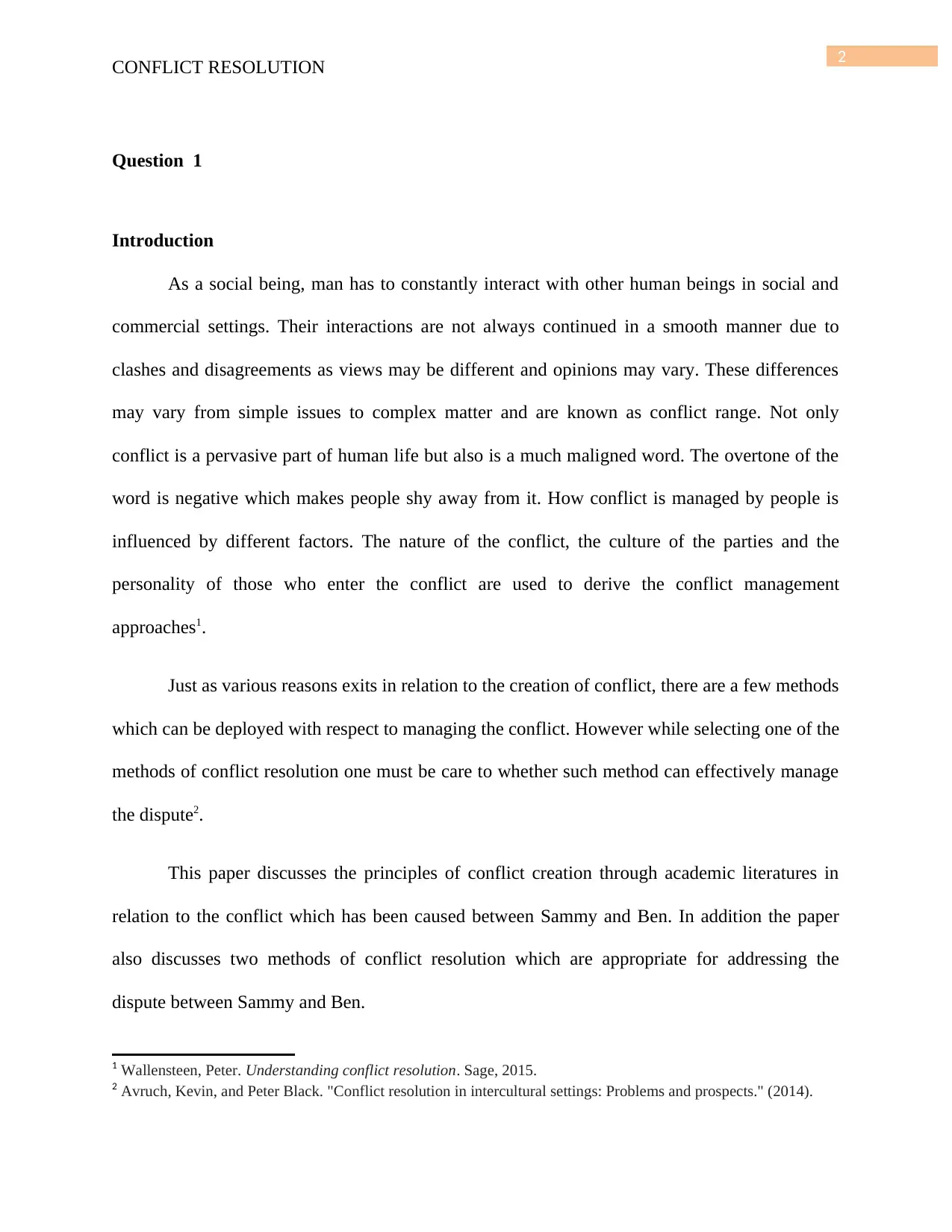
2
CONFLICT RESOLUTION
Question 1
Introduction
As a social being, man has to constantly interact with other human beings in social and
commercial settings. Their interactions are not always continued in a smooth manner due to
clashes and disagreements as views may be different and opinions may vary. These differences
may vary from simple issues to complex matter and are known as conflict range. Not only
conflict is a pervasive part of human life but also is a much maligned word. The overtone of the
word is negative which makes people shy away from it. How conflict is managed by people is
influenced by different factors. The nature of the conflict, the culture of the parties and the
personality of those who enter the conflict are used to derive the conflict management
approaches1.
Just as various reasons exits in relation to the creation of conflict, there are a few methods
which can be deployed with respect to managing the conflict. However while selecting one of the
methods of conflict resolution one must be care to whether such method can effectively manage
the dispute2.
This paper discusses the principles of conflict creation through academic literatures in
relation to the conflict which has been caused between Sammy and Ben. In addition the paper
also discusses two methods of conflict resolution which are appropriate for addressing the
dispute between Sammy and Ben.
1 Wallensteen, Peter. Understanding conflict resolution. Sage, 2015.
2 Avruch, Kevin, and Peter Black. "Conflict resolution in intercultural settings: Problems and prospects." (2014).
CONFLICT RESOLUTION
Question 1
Introduction
As a social being, man has to constantly interact with other human beings in social and
commercial settings. Their interactions are not always continued in a smooth manner due to
clashes and disagreements as views may be different and opinions may vary. These differences
may vary from simple issues to complex matter and are known as conflict range. Not only
conflict is a pervasive part of human life but also is a much maligned word. The overtone of the
word is negative which makes people shy away from it. How conflict is managed by people is
influenced by different factors. The nature of the conflict, the culture of the parties and the
personality of those who enter the conflict are used to derive the conflict management
approaches1.
Just as various reasons exits in relation to the creation of conflict, there are a few methods
which can be deployed with respect to managing the conflict. However while selecting one of the
methods of conflict resolution one must be care to whether such method can effectively manage
the dispute2.
This paper discusses the principles of conflict creation through academic literatures in
relation to the conflict which has been caused between Sammy and Ben. In addition the paper
also discusses two methods of conflict resolution which are appropriate for addressing the
dispute between Sammy and Ben.
1 Wallensteen, Peter. Understanding conflict resolution. Sage, 2015.
2 Avruch, Kevin, and Peter Black. "Conflict resolution in intercultural settings: Problems and prospects." (2014).
⊘ This is a preview!⊘
Do you want full access?
Subscribe today to unlock all pages.

Trusted by 1+ million students worldwide
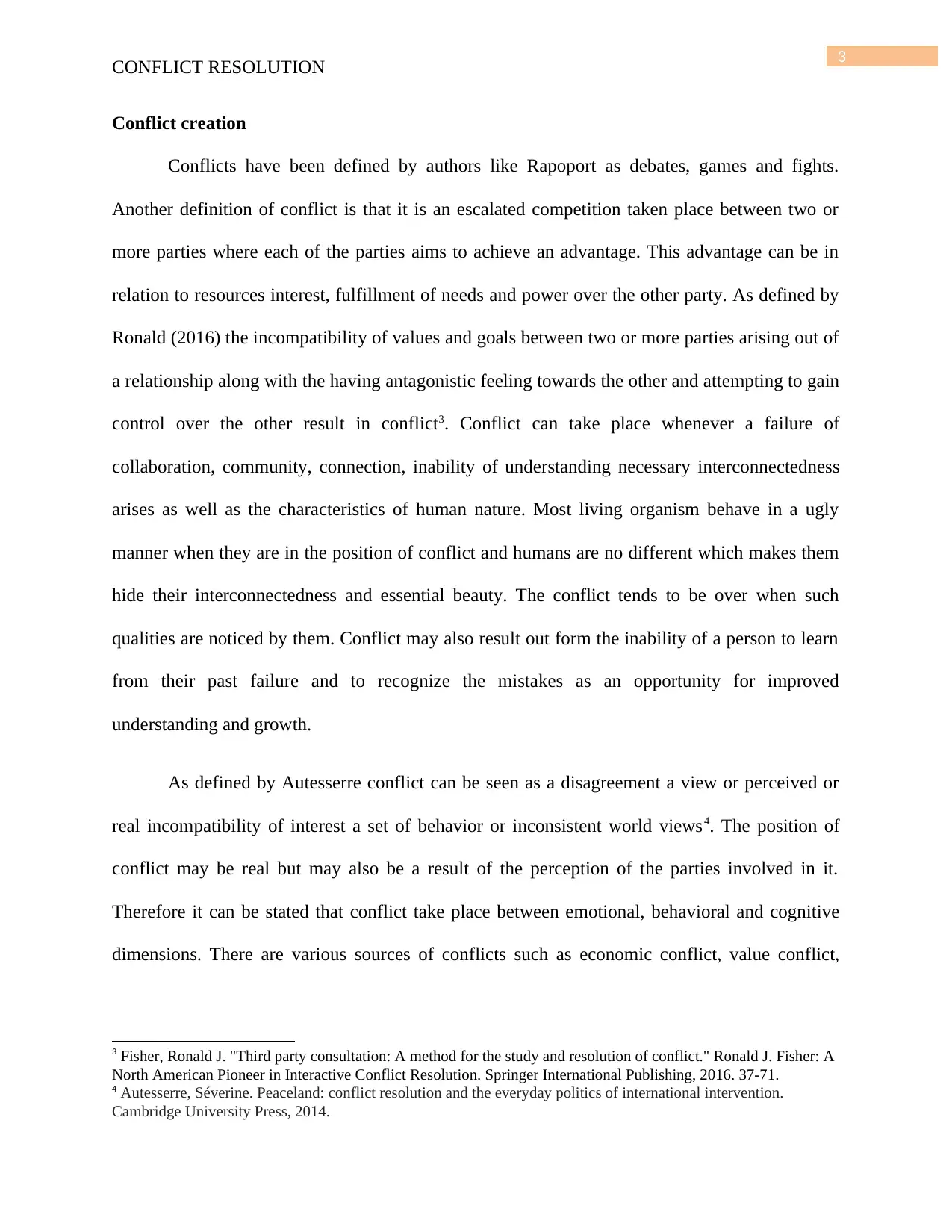
3
CONFLICT RESOLUTION
Conflict creation
Conflicts have been defined by authors like Rapoport as debates, games and fights.
Another definition of conflict is that it is an escalated competition taken place between two or
more parties where each of the parties aims to achieve an advantage. This advantage can be in
relation to resources interest, fulfillment of needs and power over the other party. As defined by
Ronald (2016) the incompatibility of values and goals between two or more parties arising out of
a relationship along with the having antagonistic feeling towards the other and attempting to gain
control over the other result in conflict3. Conflict can take place whenever a failure of
collaboration, community, connection, inability of understanding necessary interconnectedness
arises as well as the characteristics of human nature. Most living organism behave in a ugly
manner when they are in the position of conflict and humans are no different which makes them
hide their interconnectedness and essential beauty. The conflict tends to be over when such
qualities are noticed by them. Conflict may also result out form the inability of a person to learn
from their past failure and to recognize the mistakes as an opportunity for improved
understanding and growth.
As defined by Autesserre conflict can be seen as a disagreement a view or perceived or
real incompatibility of interest a set of behavior or inconsistent world views4. The position of
conflict may be real but may also be a result of the perception of the parties involved in it.
Therefore it can be stated that conflict take place between emotional, behavioral and cognitive
dimensions. There are various sources of conflicts such as economic conflict, value conflict,
3 Fisher, Ronald J. "Third party consultation: A method for the study and resolution of conflict." Ronald J. Fisher: A
North American Pioneer in Interactive Conflict Resolution. Springer International Publishing, 2016. 37-71.
4 Autesserre, Séverine. Peaceland: conflict resolution and the everyday politics of international intervention.
Cambridge University Press, 2014.
CONFLICT RESOLUTION
Conflict creation
Conflicts have been defined by authors like Rapoport as debates, games and fights.
Another definition of conflict is that it is an escalated competition taken place between two or
more parties where each of the parties aims to achieve an advantage. This advantage can be in
relation to resources interest, fulfillment of needs and power over the other party. As defined by
Ronald (2016) the incompatibility of values and goals between two or more parties arising out of
a relationship along with the having antagonistic feeling towards the other and attempting to gain
control over the other result in conflict3. Conflict can take place whenever a failure of
collaboration, community, connection, inability of understanding necessary interconnectedness
arises as well as the characteristics of human nature. Most living organism behave in a ugly
manner when they are in the position of conflict and humans are no different which makes them
hide their interconnectedness and essential beauty. The conflict tends to be over when such
qualities are noticed by them. Conflict may also result out form the inability of a person to learn
from their past failure and to recognize the mistakes as an opportunity for improved
understanding and growth.
As defined by Autesserre conflict can be seen as a disagreement a view or perceived or
real incompatibility of interest a set of behavior or inconsistent world views4. The position of
conflict may be real but may also be a result of the perception of the parties involved in it.
Therefore it can be stated that conflict take place between emotional, behavioral and cognitive
dimensions. There are various sources of conflicts such as economic conflict, value conflict,
3 Fisher, Ronald J. "Third party consultation: A method for the study and resolution of conflict." Ronald J. Fisher: A
North American Pioneer in Interactive Conflict Resolution. Springer International Publishing, 2016. 37-71.
4 Autesserre, Séverine. Peaceland: conflict resolution and the everyday politics of international intervention.
Cambridge University Press, 2014.
Paraphrase This Document
Need a fresh take? Get an instant paraphrase of this document with our AI Paraphraser
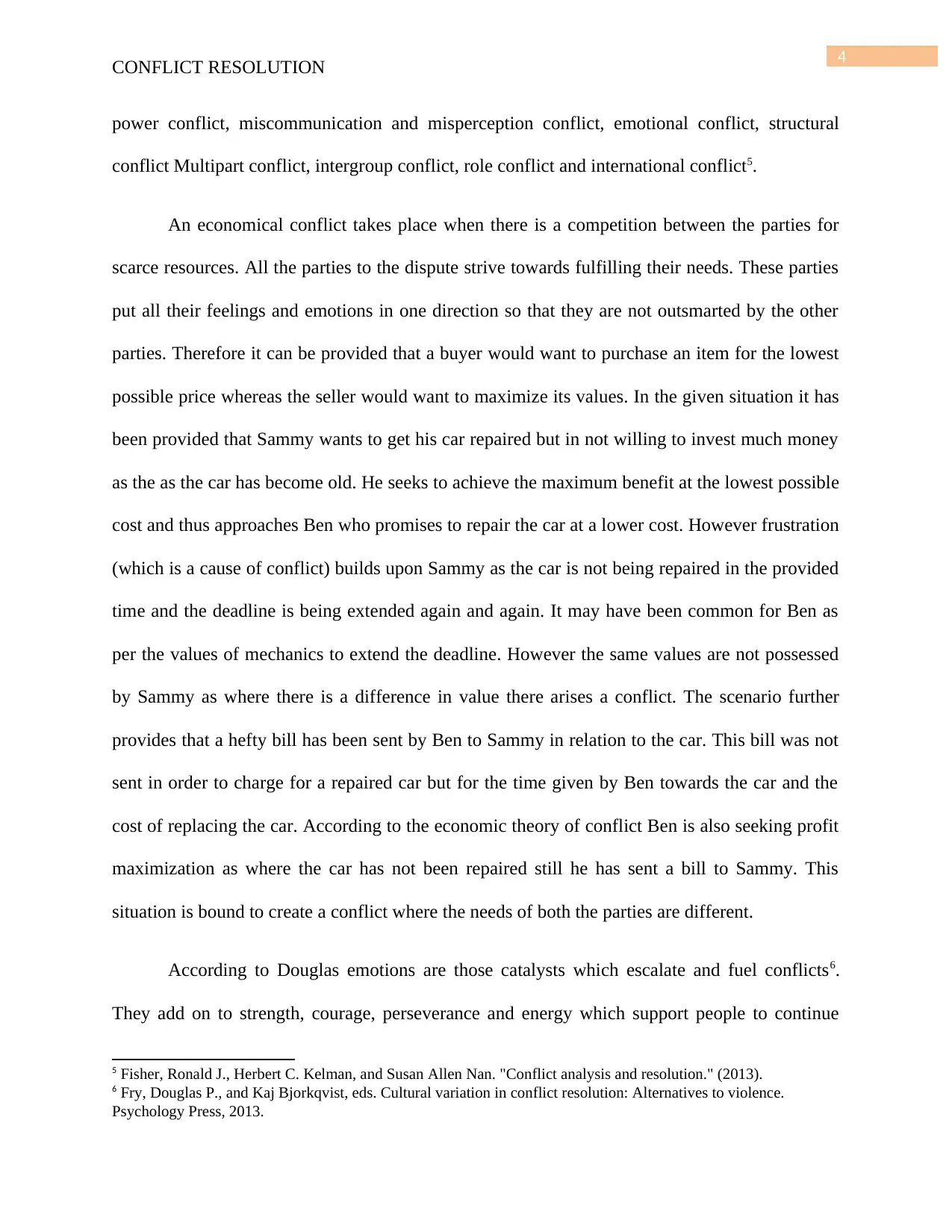
4
CONFLICT RESOLUTION
power conflict, miscommunication and misperception conflict, emotional conflict, structural
conflict Multipart conflict, intergroup conflict, role conflict and international conflict5.
An economical conflict takes place when there is a competition between the parties for
scarce resources. All the parties to the dispute strive towards fulfilling their needs. These parties
put all their feelings and emotions in one direction so that they are not outsmarted by the other
parties. Therefore it can be provided that a buyer would want to purchase an item for the lowest
possible price whereas the seller would want to maximize its values. In the given situation it has
been provided that Sammy wants to get his car repaired but in not willing to invest much money
as the as the car has become old. He seeks to achieve the maximum benefit at the lowest possible
cost and thus approaches Ben who promises to repair the car at a lower cost. However frustration
(which is a cause of conflict) builds upon Sammy as the car is not being repaired in the provided
time and the deadline is being extended again and again. It may have been common for Ben as
per the values of mechanics to extend the deadline. However the same values are not possessed
by Sammy as where there is a difference in value there arises a conflict. The scenario further
provides that a hefty bill has been sent by Ben to Sammy in relation to the car. This bill was not
sent in order to charge for a repaired car but for the time given by Ben towards the car and the
cost of replacing the car. According to the economic theory of conflict Ben is also seeking profit
maximization as where the car has not been repaired still he has sent a bill to Sammy. This
situation is bound to create a conflict where the needs of both the parties are different.
According to Douglas emotions are those catalysts which escalate and fuel conflicts6.
They add on to strength, courage, perseverance and energy which support people to continue
5 Fisher, Ronald J., Herbert C. Kelman, and Susan Allen Nan. "Conflict analysis and resolution." (2013).
6 Fry, Douglas P., and Kaj Bjorkqvist, eds. Cultural variation in conflict resolution: Alternatives to violence.
Psychology Press, 2013.
CONFLICT RESOLUTION
power conflict, miscommunication and misperception conflict, emotional conflict, structural
conflict Multipart conflict, intergroup conflict, role conflict and international conflict5.
An economical conflict takes place when there is a competition between the parties for
scarce resources. All the parties to the dispute strive towards fulfilling their needs. These parties
put all their feelings and emotions in one direction so that they are not outsmarted by the other
parties. Therefore it can be provided that a buyer would want to purchase an item for the lowest
possible price whereas the seller would want to maximize its values. In the given situation it has
been provided that Sammy wants to get his car repaired but in not willing to invest much money
as the as the car has become old. He seeks to achieve the maximum benefit at the lowest possible
cost and thus approaches Ben who promises to repair the car at a lower cost. However frustration
(which is a cause of conflict) builds upon Sammy as the car is not being repaired in the provided
time and the deadline is being extended again and again. It may have been common for Ben as
per the values of mechanics to extend the deadline. However the same values are not possessed
by Sammy as where there is a difference in value there arises a conflict. The scenario further
provides that a hefty bill has been sent by Ben to Sammy in relation to the car. This bill was not
sent in order to charge for a repaired car but for the time given by Ben towards the car and the
cost of replacing the car. According to the economic theory of conflict Ben is also seeking profit
maximization as where the car has not been repaired still he has sent a bill to Sammy. This
situation is bound to create a conflict where the needs of both the parties are different.
According to Douglas emotions are those catalysts which escalate and fuel conflicts6.
They add on to strength, courage, perseverance and energy which support people to continue
5 Fisher, Ronald J., Herbert C. Kelman, and Susan Allen Nan. "Conflict analysis and resolution." (2013).
6 Fry, Douglas P., and Kaj Bjorkqvist, eds. Cultural variation in conflict resolution: Alternatives to violence.
Psychology Press, 2013.
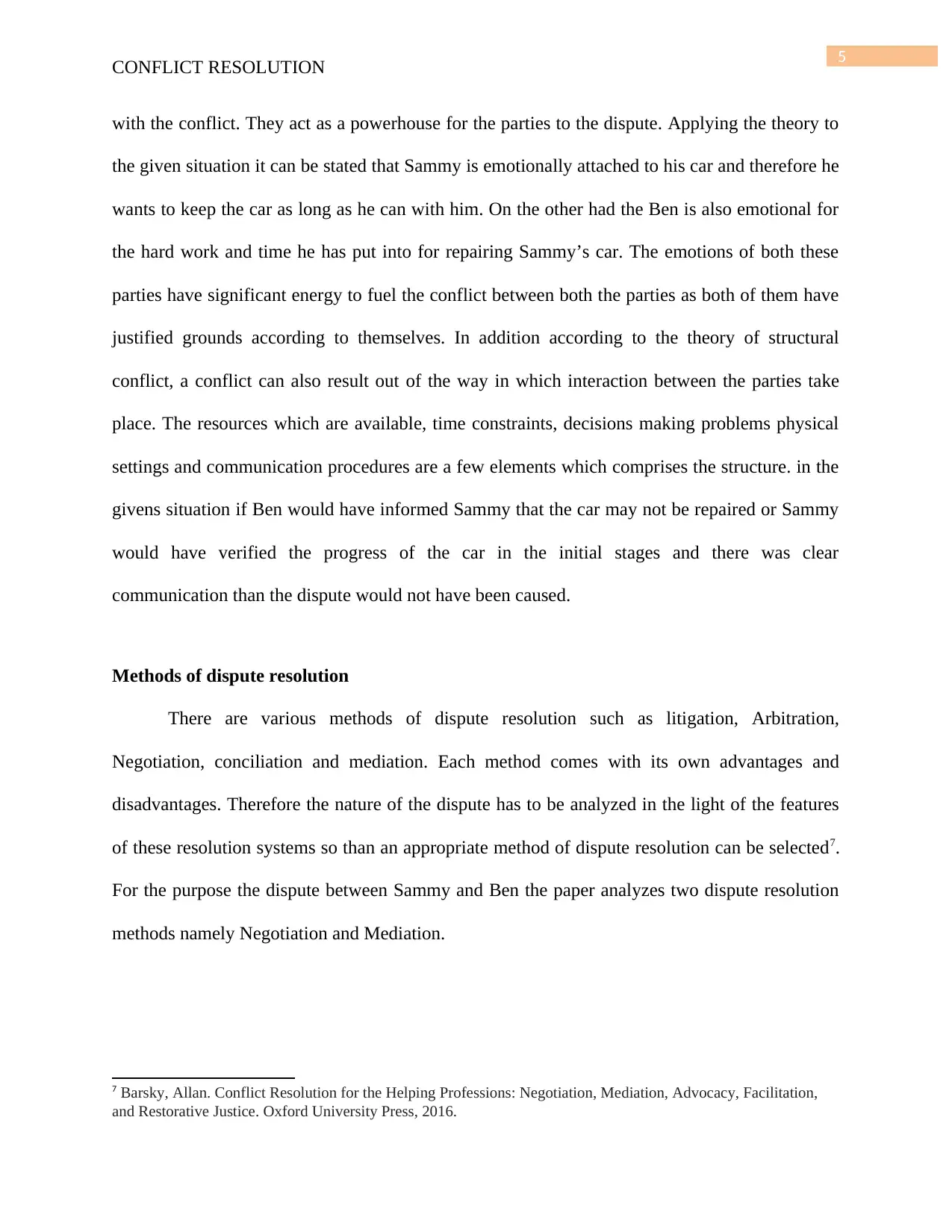
5
CONFLICT RESOLUTION
with the conflict. They act as a powerhouse for the parties to the dispute. Applying the theory to
the given situation it can be stated that Sammy is emotionally attached to his car and therefore he
wants to keep the car as long as he can with him. On the other had the Ben is also emotional for
the hard work and time he has put into for repairing Sammy’s car. The emotions of both these
parties have significant energy to fuel the conflict between both the parties as both of them have
justified grounds according to themselves. In addition according to the theory of structural
conflict, a conflict can also result out of the way in which interaction between the parties take
place. The resources which are available, time constraints, decisions making problems physical
settings and communication procedures are a few elements which comprises the structure. in the
givens situation if Ben would have informed Sammy that the car may not be repaired or Sammy
would have verified the progress of the car in the initial stages and there was clear
communication than the dispute would not have been caused.
Methods of dispute resolution
There are various methods of dispute resolution such as litigation, Arbitration,
Negotiation, conciliation and mediation. Each method comes with its own advantages and
disadvantages. Therefore the nature of the dispute has to be analyzed in the light of the features
of these resolution systems so than an appropriate method of dispute resolution can be selected7.
For the purpose the dispute between Sammy and Ben the paper analyzes two dispute resolution
methods namely Negotiation and Mediation.
7 Barsky, Allan. Conflict Resolution for the Helping Professions: Negotiation, Mediation, Advocacy, Facilitation,
and Restorative Justice. Oxford University Press, 2016.
CONFLICT RESOLUTION
with the conflict. They act as a powerhouse for the parties to the dispute. Applying the theory to
the given situation it can be stated that Sammy is emotionally attached to his car and therefore he
wants to keep the car as long as he can with him. On the other had the Ben is also emotional for
the hard work and time he has put into for repairing Sammy’s car. The emotions of both these
parties have significant energy to fuel the conflict between both the parties as both of them have
justified grounds according to themselves. In addition according to the theory of structural
conflict, a conflict can also result out of the way in which interaction between the parties take
place. The resources which are available, time constraints, decisions making problems physical
settings and communication procedures are a few elements which comprises the structure. in the
givens situation if Ben would have informed Sammy that the car may not be repaired or Sammy
would have verified the progress of the car in the initial stages and there was clear
communication than the dispute would not have been caused.
Methods of dispute resolution
There are various methods of dispute resolution such as litigation, Arbitration,
Negotiation, conciliation and mediation. Each method comes with its own advantages and
disadvantages. Therefore the nature of the dispute has to be analyzed in the light of the features
of these resolution systems so than an appropriate method of dispute resolution can be selected7.
For the purpose the dispute between Sammy and Ben the paper analyzes two dispute resolution
methods namely Negotiation and Mediation.
7 Barsky, Allan. Conflict Resolution for the Helping Professions: Negotiation, Mediation, Advocacy, Facilitation,
and Restorative Justice. Oxford University Press, 2016.
⊘ This is a preview!⊘
Do you want full access?
Subscribe today to unlock all pages.

Trusted by 1+ million students worldwide
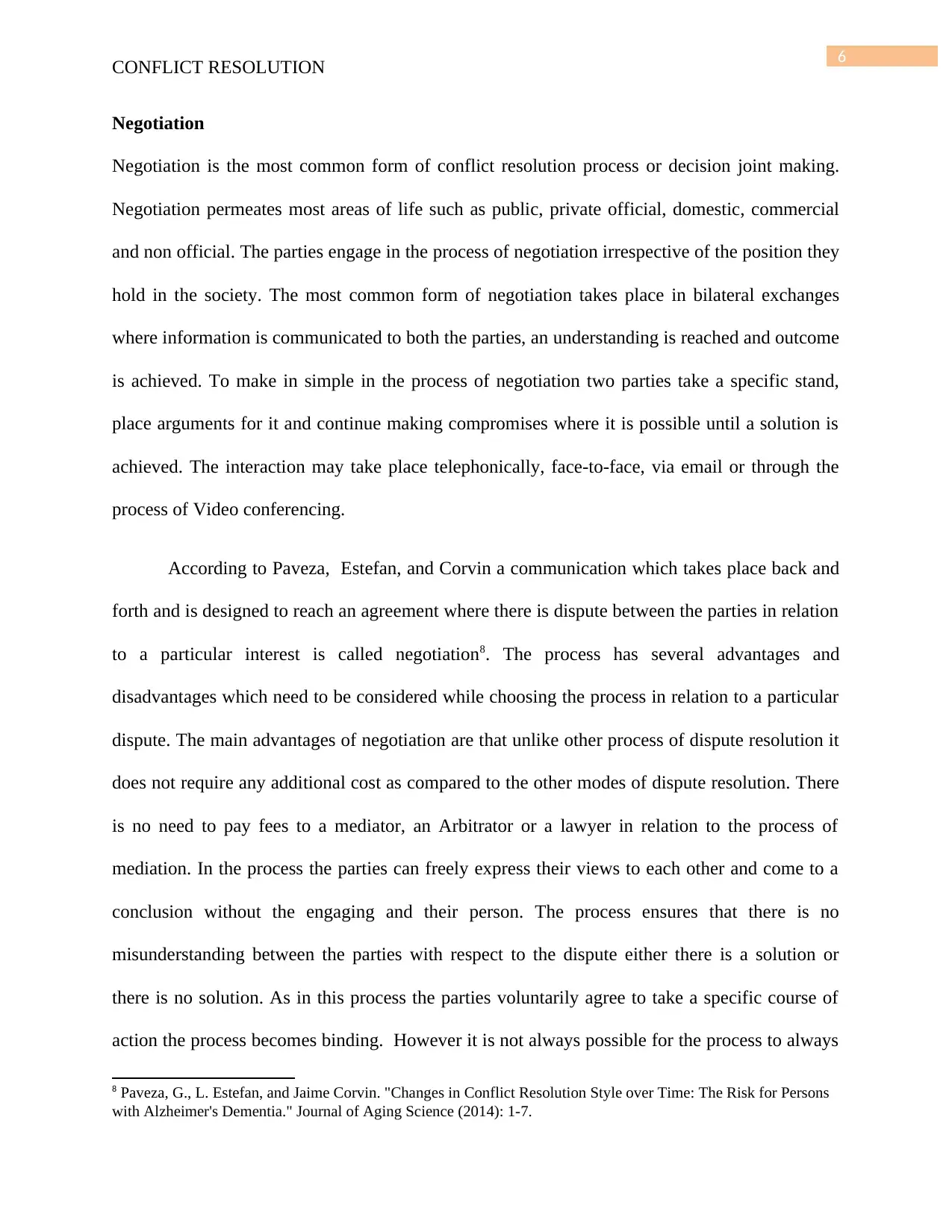
6
CONFLICT RESOLUTION
Negotiation
Negotiation is the most common form of conflict resolution process or decision joint making.
Negotiation permeates most areas of life such as public, private official, domestic, commercial
and non official. The parties engage in the process of negotiation irrespective of the position they
hold in the society. The most common form of negotiation takes place in bilateral exchanges
where information is communicated to both the parties, an understanding is reached and outcome
is achieved. To make in simple in the process of negotiation two parties take a specific stand,
place arguments for it and continue making compromises where it is possible until a solution is
achieved. The interaction may take place telephonically, face-to-face, via email or through the
process of Video conferencing.
According to Paveza, Estefan, and Corvin a communication which takes place back and
forth and is designed to reach an agreement where there is dispute between the parties in relation
to a particular interest is called negotiation8. The process has several advantages and
disadvantages which need to be considered while choosing the process in relation to a particular
dispute. The main advantages of negotiation are that unlike other process of dispute resolution it
does not require any additional cost as compared to the other modes of dispute resolution. There
is no need to pay fees to a mediator, an Arbitrator or a lawyer in relation to the process of
mediation. In the process the parties can freely express their views to each other and come to a
conclusion without the engaging and their person. The process ensures that there is no
misunderstanding between the parties with respect to the dispute either there is a solution or
there is no solution. As in this process the parties voluntarily agree to take a specific course of
action the process becomes binding. However it is not always possible for the process to always
8 Paveza, G., L. Estefan, and Jaime Corvin. "Changes in Conflict Resolution Style over Time: The Risk for Persons
with Alzheimer's Dementia." Journal of Aging Science (2014): 1-7.
CONFLICT RESOLUTION
Negotiation
Negotiation is the most common form of conflict resolution process or decision joint making.
Negotiation permeates most areas of life such as public, private official, domestic, commercial
and non official. The parties engage in the process of negotiation irrespective of the position they
hold in the society. The most common form of negotiation takes place in bilateral exchanges
where information is communicated to both the parties, an understanding is reached and outcome
is achieved. To make in simple in the process of negotiation two parties take a specific stand,
place arguments for it and continue making compromises where it is possible until a solution is
achieved. The interaction may take place telephonically, face-to-face, via email or through the
process of Video conferencing.
According to Paveza, Estefan, and Corvin a communication which takes place back and
forth and is designed to reach an agreement where there is dispute between the parties in relation
to a particular interest is called negotiation8. The process has several advantages and
disadvantages which need to be considered while choosing the process in relation to a particular
dispute. The main advantages of negotiation are that unlike other process of dispute resolution it
does not require any additional cost as compared to the other modes of dispute resolution. There
is no need to pay fees to a mediator, an Arbitrator or a lawyer in relation to the process of
mediation. In the process the parties can freely express their views to each other and come to a
conclusion without the engaging and their person. The process ensures that there is no
misunderstanding between the parties with respect to the dispute either there is a solution or
there is no solution. As in this process the parties voluntarily agree to take a specific course of
action the process becomes binding. However it is not always possible for the process to always
8 Paveza, G., L. Estefan, and Jaime Corvin. "Changes in Conflict Resolution Style over Time: The Risk for Persons
with Alzheimer's Dementia." Journal of Aging Science (2014): 1-7.
Paraphrase This Document
Need a fresh take? Get an instant paraphrase of this document with our AI Paraphraser
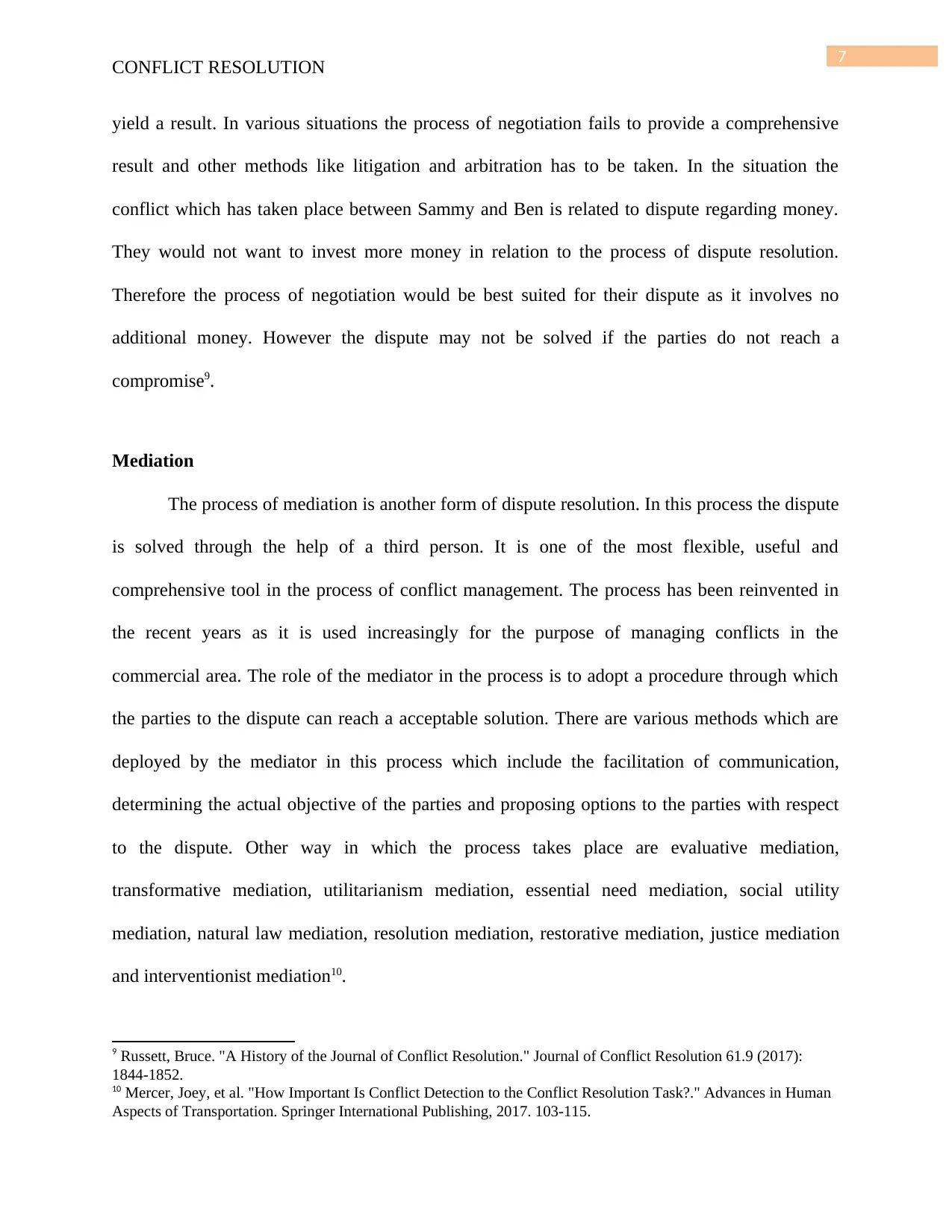
7
CONFLICT RESOLUTION
yield a result. In various situations the process of negotiation fails to provide a comprehensive
result and other methods like litigation and arbitration has to be taken. In the situation the
conflict which has taken place between Sammy and Ben is related to dispute regarding money.
They would not want to invest more money in relation to the process of dispute resolution.
Therefore the process of negotiation would be best suited for their dispute as it involves no
additional money. However the dispute may not be solved if the parties do not reach a
compromise9.
Mediation
The process of mediation is another form of dispute resolution. In this process the dispute
is solved through the help of a third person. It is one of the most flexible, useful and
comprehensive tool in the process of conflict management. The process has been reinvented in
the recent years as it is used increasingly for the purpose of managing conflicts in the
commercial area. The role of the mediator in the process is to adopt a procedure through which
the parties to the dispute can reach a acceptable solution. There are various methods which are
deployed by the mediator in this process which include the facilitation of communication,
determining the actual objective of the parties and proposing options to the parties with respect
to the dispute. Other way in which the process takes place are evaluative mediation,
transformative mediation, utilitarianism mediation, essential need mediation, social utility
mediation, natural law mediation, resolution mediation, restorative mediation, justice mediation
and interventionist mediation10.
9 Russett, Bruce. "A History of the Journal of Conflict Resolution." Journal of Conflict Resolution 61.9 (2017):
1844-1852.
10 Mercer, Joey, et al. "How Important Is Conflict Detection to the Conflict Resolution Task?." Advances in Human
Aspects of Transportation. Springer International Publishing, 2017. 103-115.
CONFLICT RESOLUTION
yield a result. In various situations the process of negotiation fails to provide a comprehensive
result and other methods like litigation and arbitration has to be taken. In the situation the
conflict which has taken place between Sammy and Ben is related to dispute regarding money.
They would not want to invest more money in relation to the process of dispute resolution.
Therefore the process of negotiation would be best suited for their dispute as it involves no
additional money. However the dispute may not be solved if the parties do not reach a
compromise9.
Mediation
The process of mediation is another form of dispute resolution. In this process the dispute
is solved through the help of a third person. It is one of the most flexible, useful and
comprehensive tool in the process of conflict management. The process has been reinvented in
the recent years as it is used increasingly for the purpose of managing conflicts in the
commercial area. The role of the mediator in the process is to adopt a procedure through which
the parties to the dispute can reach a acceptable solution. There are various methods which are
deployed by the mediator in this process which include the facilitation of communication,
determining the actual objective of the parties and proposing options to the parties with respect
to the dispute. Other way in which the process takes place are evaluative mediation,
transformative mediation, utilitarianism mediation, essential need mediation, social utility
mediation, natural law mediation, resolution mediation, restorative mediation, justice mediation
and interventionist mediation10.
9 Russett, Bruce. "A History of the Journal of Conflict Resolution." Journal of Conflict Resolution 61.9 (2017):
1844-1852.
10 Mercer, Joey, et al. "How Important Is Conflict Detection to the Conflict Resolution Task?." Advances in Human
Aspects of Transportation. Springer International Publishing, 2017. 103-115.
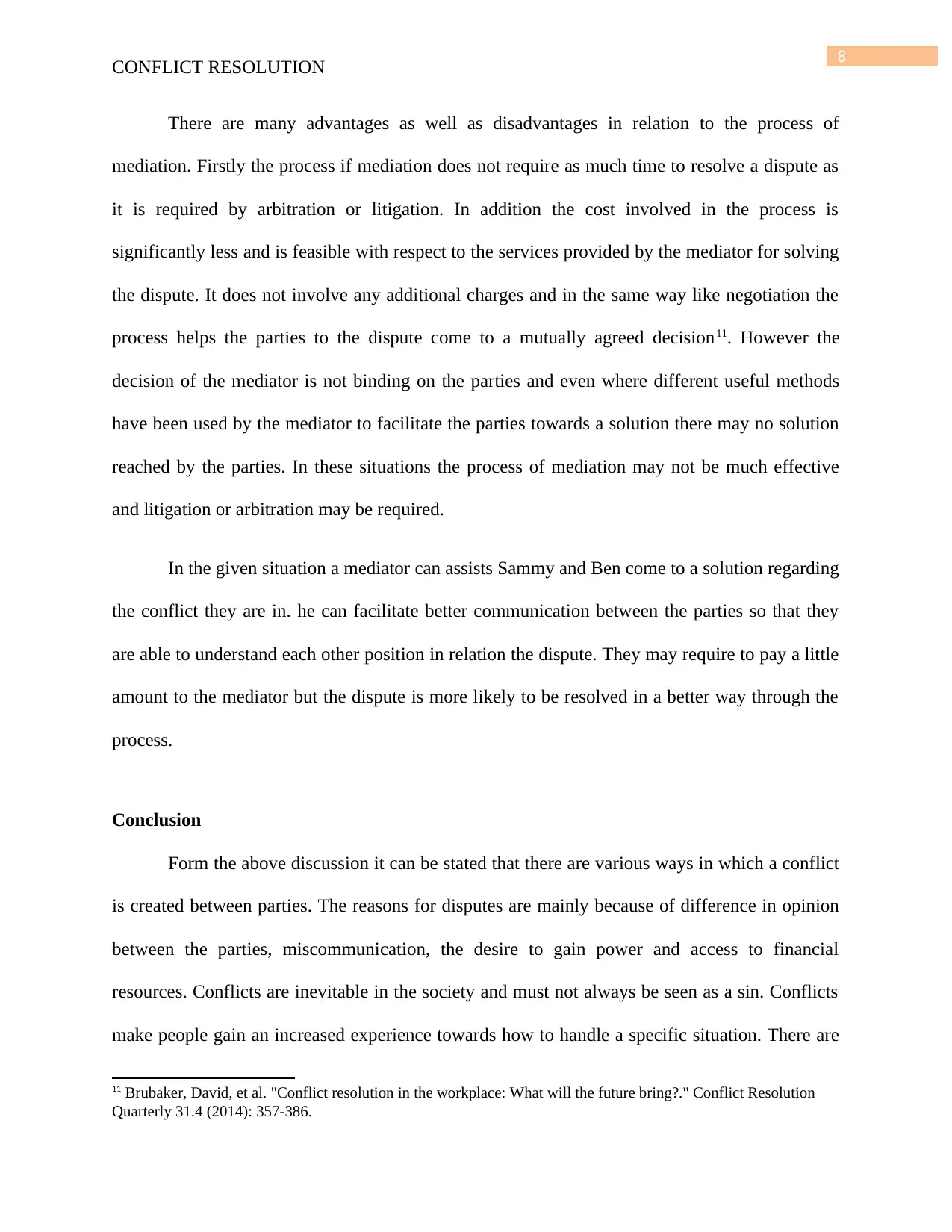
8
CONFLICT RESOLUTION
There are many advantages as well as disadvantages in relation to the process of
mediation. Firstly the process if mediation does not require as much time to resolve a dispute as
it is required by arbitration or litigation. In addition the cost involved in the process is
significantly less and is feasible with respect to the services provided by the mediator for solving
the dispute. It does not involve any additional charges and in the same way like negotiation the
process helps the parties to the dispute come to a mutually agreed decision11. However the
decision of the mediator is not binding on the parties and even where different useful methods
have been used by the mediator to facilitate the parties towards a solution there may no solution
reached by the parties. In these situations the process of mediation may not be much effective
and litigation or arbitration may be required.
In the given situation a mediator can assists Sammy and Ben come to a solution regarding
the conflict they are in. he can facilitate better communication between the parties so that they
are able to understand each other position in relation the dispute. They may require to pay a little
amount to the mediator but the dispute is more likely to be resolved in a better way through the
process.
Conclusion
Form the above discussion it can be stated that there are various ways in which a conflict
is created between parties. The reasons for disputes are mainly because of difference in opinion
between the parties, miscommunication, the desire to gain power and access to financial
resources. Conflicts are inevitable in the society and must not always be seen as a sin. Conflicts
make people gain an increased experience towards how to handle a specific situation. There are
11 Brubaker, David, et al. "Conflict resolution in the workplace: What will the future bring?." Conflict Resolution
Quarterly 31.4 (2014): 357-386.
CONFLICT RESOLUTION
There are many advantages as well as disadvantages in relation to the process of
mediation. Firstly the process if mediation does not require as much time to resolve a dispute as
it is required by arbitration or litigation. In addition the cost involved in the process is
significantly less and is feasible with respect to the services provided by the mediator for solving
the dispute. It does not involve any additional charges and in the same way like negotiation the
process helps the parties to the dispute come to a mutually agreed decision11. However the
decision of the mediator is not binding on the parties and even where different useful methods
have been used by the mediator to facilitate the parties towards a solution there may no solution
reached by the parties. In these situations the process of mediation may not be much effective
and litigation or arbitration may be required.
In the given situation a mediator can assists Sammy and Ben come to a solution regarding
the conflict they are in. he can facilitate better communication between the parties so that they
are able to understand each other position in relation the dispute. They may require to pay a little
amount to the mediator but the dispute is more likely to be resolved in a better way through the
process.
Conclusion
Form the above discussion it can be stated that there are various ways in which a conflict
is created between parties. The reasons for disputes are mainly because of difference in opinion
between the parties, miscommunication, the desire to gain power and access to financial
resources. Conflicts are inevitable in the society and must not always be seen as a sin. Conflicts
make people gain an increased experience towards how to handle a specific situation. There are
11 Brubaker, David, et al. "Conflict resolution in the workplace: What will the future bring?." Conflict Resolution
Quarterly 31.4 (2014): 357-386.
⊘ This is a preview!⊘
Do you want full access?
Subscribe today to unlock all pages.

Trusted by 1+ million students worldwide

9
CONFLICT RESOLUTION
various methods of conflict resolution. These methods have to be selected based on their nature
of the dispute. In the given situation the best applicable methods are mediation and negotiation.
CONFLICT RESOLUTION
various methods of conflict resolution. These methods have to be selected based on their nature
of the dispute. In the given situation the best applicable methods are mediation and negotiation.
Paraphrase This Document
Need a fresh take? Get an instant paraphrase of this document with our AI Paraphraser
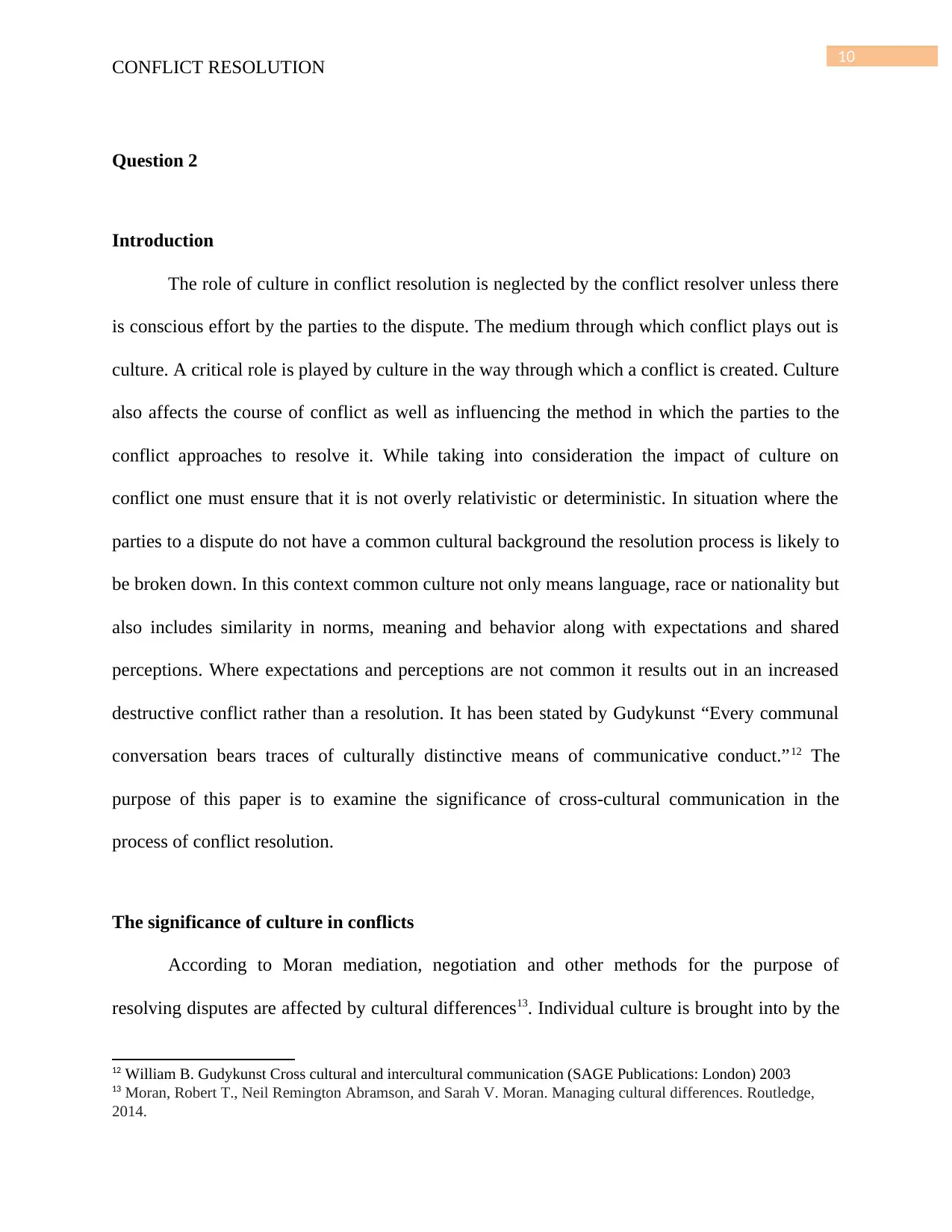
10
CONFLICT RESOLUTION
Question 2
Introduction
The role of culture in conflict resolution is neglected by the conflict resolver unless there
is conscious effort by the parties to the dispute. The medium through which conflict plays out is
culture. A critical role is played by culture in the way through which a conflict is created. Culture
also affects the course of conflict as well as influencing the method in which the parties to the
conflict approaches to resolve it. While taking into consideration the impact of culture on
conflict one must ensure that it is not overly relativistic or deterministic. In situation where the
parties to a dispute do not have a common cultural background the resolution process is likely to
be broken down. In this context common culture not only means language, race or nationality but
also includes similarity in norms, meaning and behavior along with expectations and shared
perceptions. Where expectations and perceptions are not common it results out in an increased
destructive conflict rather than a resolution. It has been stated by Gudykunst “Every communal
conversation bears traces of culturally distinctive means of communicative conduct.”12 The
purpose of this paper is to examine the significance of cross-cultural communication in the
process of conflict resolution.
The significance of culture in conflicts
According to Moran mediation, negotiation and other methods for the purpose of
resolving disputes are affected by cultural differences13. Individual culture is brought into by the
12 William B. Gudykunst Cross cultural and intercultural communication (SAGE Publications: London) 2003
13 Moran, Robert T., Neil Remington Abramson, and Sarah V. Moran. Managing cultural differences. Routledge,
2014.
CONFLICT RESOLUTION
Question 2
Introduction
The role of culture in conflict resolution is neglected by the conflict resolver unless there
is conscious effort by the parties to the dispute. The medium through which conflict plays out is
culture. A critical role is played by culture in the way through which a conflict is created. Culture
also affects the course of conflict as well as influencing the method in which the parties to the
conflict approaches to resolve it. While taking into consideration the impact of culture on
conflict one must ensure that it is not overly relativistic or deterministic. In situation where the
parties to a dispute do not have a common cultural background the resolution process is likely to
be broken down. In this context common culture not only means language, race or nationality but
also includes similarity in norms, meaning and behavior along with expectations and shared
perceptions. Where expectations and perceptions are not common it results out in an increased
destructive conflict rather than a resolution. It has been stated by Gudykunst “Every communal
conversation bears traces of culturally distinctive means of communicative conduct.”12 The
purpose of this paper is to examine the significance of cross-cultural communication in the
process of conflict resolution.
The significance of culture in conflicts
According to Moran mediation, negotiation and other methods for the purpose of
resolving disputes are affected by cultural differences13. Individual culture is brought into by the
12 William B. Gudykunst Cross cultural and intercultural communication (SAGE Publications: London) 2003
13 Moran, Robert T., Neil Remington Abramson, and Sarah V. Moran. Managing cultural differences. Routledge,
2014.
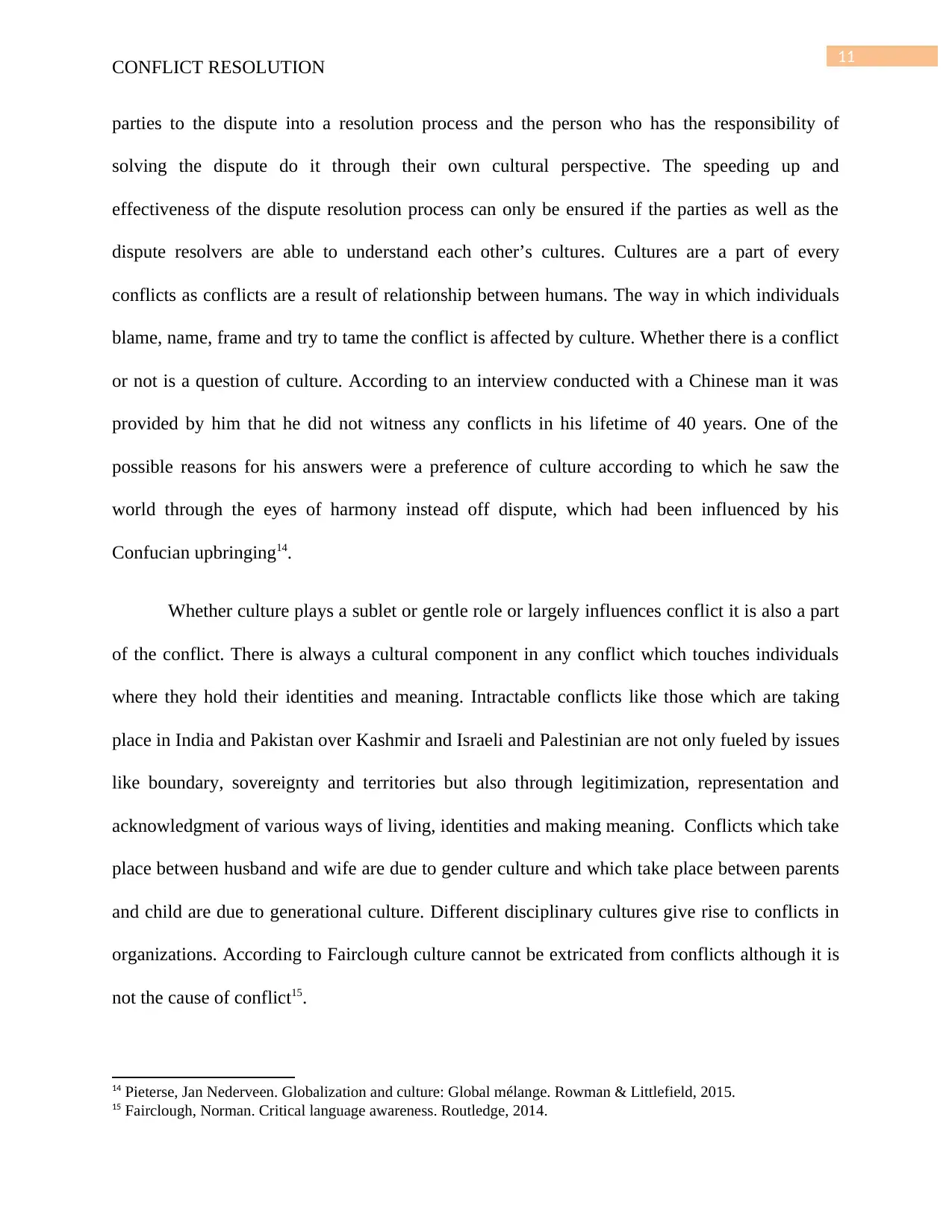
11
CONFLICT RESOLUTION
parties to the dispute into a resolution process and the person who has the responsibility of
solving the dispute do it through their own cultural perspective. The speeding up and
effectiveness of the dispute resolution process can only be ensured if the parties as well as the
dispute resolvers are able to understand each other’s cultures. Cultures are a part of every
conflicts as conflicts are a result of relationship between humans. The way in which individuals
blame, name, frame and try to tame the conflict is affected by culture. Whether there is a conflict
or not is a question of culture. According to an interview conducted with a Chinese man it was
provided by him that he did not witness any conflicts in his lifetime of 40 years. One of the
possible reasons for his answers were a preference of culture according to which he saw the
world through the eyes of harmony instead off dispute, which had been influenced by his
Confucian upbringing14.
Whether culture plays a sublet or gentle role or largely influences conflict it is also a part
of the conflict. There is always a cultural component in any conflict which touches individuals
where they hold their identities and meaning. Intractable conflicts like those which are taking
place in India and Pakistan over Kashmir and Israeli and Palestinian are not only fueled by issues
like boundary, sovereignty and territories but also through legitimization, representation and
acknowledgment of various ways of living, identities and making meaning. Conflicts which take
place between husband and wife are due to gender culture and which take place between parents
and child are due to generational culture. Different disciplinary cultures give rise to conflicts in
organizations. According to Fairclough culture cannot be extricated from conflicts although it is
not the cause of conflict15.
14 Pieterse, Jan Nederveen. Globalization and culture: Global mélange. Rowman & Littlefield, 2015.
15 Fairclough, Norman. Critical language awareness. Routledge, 2014.
CONFLICT RESOLUTION
parties to the dispute into a resolution process and the person who has the responsibility of
solving the dispute do it through their own cultural perspective. The speeding up and
effectiveness of the dispute resolution process can only be ensured if the parties as well as the
dispute resolvers are able to understand each other’s cultures. Cultures are a part of every
conflicts as conflicts are a result of relationship between humans. The way in which individuals
blame, name, frame and try to tame the conflict is affected by culture. Whether there is a conflict
or not is a question of culture. According to an interview conducted with a Chinese man it was
provided by him that he did not witness any conflicts in his lifetime of 40 years. One of the
possible reasons for his answers were a preference of culture according to which he saw the
world through the eyes of harmony instead off dispute, which had been influenced by his
Confucian upbringing14.
Whether culture plays a sublet or gentle role or largely influences conflict it is also a part
of the conflict. There is always a cultural component in any conflict which touches individuals
where they hold their identities and meaning. Intractable conflicts like those which are taking
place in India and Pakistan over Kashmir and Israeli and Palestinian are not only fueled by issues
like boundary, sovereignty and territories but also through legitimization, representation and
acknowledgment of various ways of living, identities and making meaning. Conflicts which take
place between husband and wife are due to gender culture and which take place between parents
and child are due to generational culture. Different disciplinary cultures give rise to conflicts in
organizations. According to Fairclough culture cannot be extricated from conflicts although it is
not the cause of conflict15.
14 Pieterse, Jan Nederveen. Globalization and culture: Global mélange. Rowman & Littlefield, 2015.
15 Fairclough, Norman. Critical language awareness. Routledge, 2014.
⊘ This is a preview!⊘
Do you want full access?
Subscribe today to unlock all pages.

Trusted by 1+ million students worldwide
1 out of 21
Related Documents
Your All-in-One AI-Powered Toolkit for Academic Success.
+13062052269
info@desklib.com
Available 24*7 on WhatsApp / Email
![[object Object]](/_next/static/media/star-bottom.7253800d.svg)
Unlock your academic potential
Copyright © 2020–2025 A2Z Services. All Rights Reserved. Developed and managed by ZUCOL.





